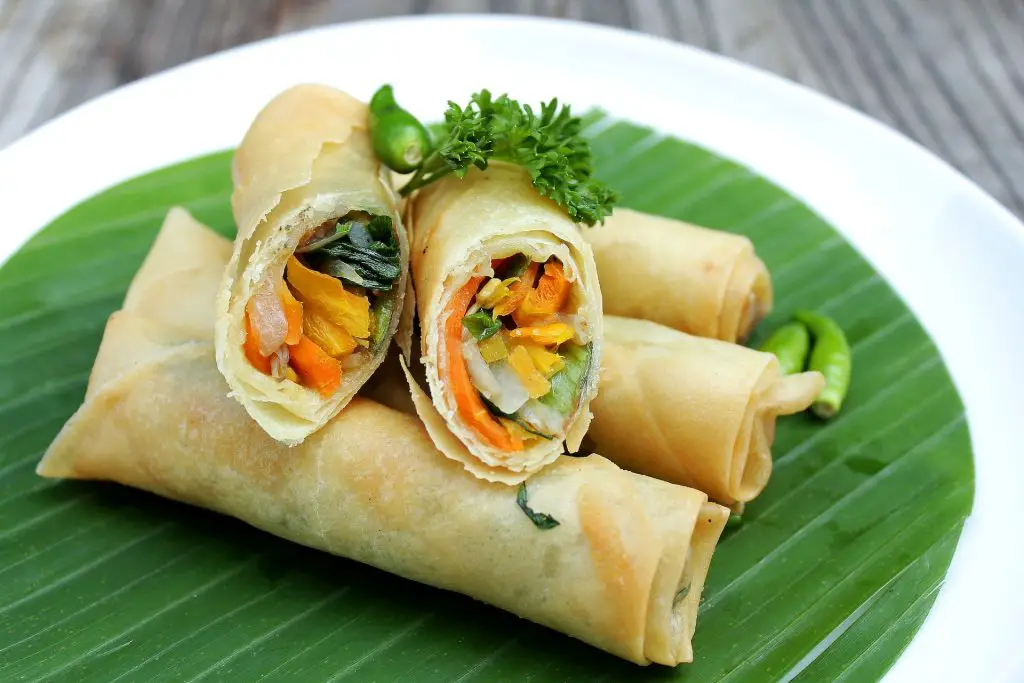Vietnamese cuisine is renowned for its balance of flavors, vibrant colors, and fresh ingredients. One of its most iconic dishes, the Vietnamese Fresh Spring Rolls (Gỏi Cuốn), exemplifies this culinary philosophy perfectly. These delectable rolls are not only a treat for the taste buds but also a feast for the eyes, showcasing the beauty of Vietnamese cuisine. In this article, we will delve into the world of Vietnamese Fresh Spring Rolls, exploring their history, ingredients, preparation, and variations.
A Glimpse into the History
The origins of Vietnamese Fresh Spring Rolls can be traced back to the heart of Vietnam. These rolls are believed to have been invented during the Vietnamese imperial era, with roots dating as far back as the 19th century. Initially, they were known as “Gỏi bì cuốn,” referring to the thin rice paper used to wrap the ingredients. Over the years, this dish evolved, and its popularity spread throughout Vietnam and beyond.
The appeal of Fresh Spring Rolls lies in their simplicity and versatility. They are often served as appetizers, snacks, or even as a light meal. Unlike their fried counterparts, such as spring rolls or egg rolls, these fresh rolls are celebrated for their health-conscious approach, making them an excellent choice for those seeking a lighter, more nutritious option.
Essential Ingredients
Before we dive into the step-by-step preparation, let’s familiarize ourselves with the essential ingredients that make up Vietnamese Fresh Spring Rolls:
Rice Paper: The delicate, translucent rice paper is the foundation of the roll. It’s what holds all the ingredients together and gives the roll its distinct texture.
Protein: Traditional choices include cooked shrimp or poached chicken, but you can also opt for tofu or other protein sources of your choice.
Fresh Vegetables: The hallmark of Fresh Spring Rolls is the abundance of fresh vegetables. Common options include lettuce, bean sprouts, cucumber, and fresh herbs like cilantro, mint, and Thai basil.
Rice Vermicelli: These thin rice noodles add a delightful chewy texture to the rolls.
Peanut Dipping Sauce: A crucial element in elevating the flavor, this sauce is made from peanuts, hoisin sauce, soy sauce, and other seasonings.
Extras: Some variations of Fresh Spring Rolls incorporate ingredients like avocado, mango, or fried shallots for an extra layer of flavor and texture.
Step-by-Step Preparation
Now that we’ve acquainted ourselves with the key ingredients, let’s walk through the step-by-step preparation of Vietnamese Fresh Spring Rolls:
Step 1: Prepare Your Workstation
Gather all your ingredients and place them within reach. You’ll need a large bowl of warm water, a clean working surface, a plate for assembling the rolls, and a damp kitchen towel to keep the rice paper pliable.
Step 2: Soften the Rice Paper
Dip a sheet of rice paper into the warm water, making sure to wet it thoroughly. Be patient as it softens; it usually takes about 15-20 seconds. Carefully remove it from the water and lay it flat on your working surface.
Step 3: Arrange the Ingredients
Place your choice of protein (shrimp, chicken, tofu) in the center of the rice paper, followed by a small portion of rice vermicelli, and then the fresh vegetables and herbs. Be mindful not to overfill the roll; you want it to be firm but not bursting.
Step 4: Fold and Roll
Fold the sides of the rice paper over the ingredients, then fold the bottom over the top. Tightly roll the entire assembly away from you, tucking in the sides as you go. The rice paper will stick to itself, sealing the roll.
Step 5: Repeat and Serve
Repeat the process with the remaining ingredients, adjusting the filling to your preference. Once you’ve assembled all the rolls, you can serve them immediately or cover them with a damp cloth to keep them fresh until serving.
Variations and Flavor Profiles
While the classic Vietnamese Fresh Spring Roll recipe is delightful on its own, there are numerous variations and flavor profiles to explore:
Vegetarian/Vegan Rolls: Replace the protein with marinated tofu, tempeh, or other meat alternatives for a vegan-friendly option.
Fruit-Infused Rolls: Add slices of ripe mango, avocado, or pineapple to the rolls for a sweet and savory twist.
Seafood Rolls: Incorporate a variety of seafood, such as crab, lobster, or scallops, for a more indulgent version.
Spicy Rolls: Boost the flavor by adding slices of fresh chili pepper or a drizzle of sriracha sauce.
Nutty Rolls: Enhance the rolls with crushed peanuts, toasted sesame seeds, or even almond slivers for a delightful crunch.
Dipping Sauces: Experiment with different dipping sauces, such as a tangy fish sauce-based dip or a sweet chili sauce for an extra kick.
Presentation and Serving
Vietnamese Fresh Spring Rolls not only taste fantastic but also look beautiful when plated thoughtfully. Here are some tips for a visually appealing presentation:
Colorful Variety: Use a variety of colorful vegetables and herbs to make the rolls visually enticing.
Slicing and Garnishes: Slice the rolls diagonally before serving to showcase the vibrant fillings. Garnish with additional fresh herbs or edible flowers for an elegant touch.
Dipping Sauces: Serve the rolls with a selection of dipping sauces in small bowls, allowing guests to customize their flavor experience.
Side Accompaniments: Pair the rolls with traditional Vietnamese side dishes like pickled vegetables or crispy prawn crackers for an authentic touch.
Vietnamese Fresh Spring Rolls are not just a dish; they are an embodiment of Vietnamese culinary philosophy—freshness, balance, and harmony. With their wide range of flavor variations and customizable fillings, these rolls are a testament to the creativity and versatility of Vietnamese cuisine.
Whether you’re a seasoned chef or a beginner in the kitchen, making Fresh Spring Rolls is an enjoyable and rewarding experience. So, gather your ingredients, prepare your workstation, and embark on a culinary journey to savor the exquisite taste and artistry of Vietnamese Fresh Spring Rolls.
Tips and Tricks for Perfect Fresh Spring Rolls
To master the art of making perfect Vietnamese Fresh Spring Rolls, here are some additional tips and tricks:
Choose High-Quality Ingredients: Freshness is key. Use the freshest vegetables and herbs available. The quality of your ingredients will directly impact the flavor of your rolls.
Prep in Advance: Prepare all your ingredients before you start assembling the rolls. Having everything ready will streamline the process and prevent the rice paper from drying out while you chop.
Use a Damp Towel: Keep a damp kitchen towel handy to cover the rice paper sheets you’re not actively using. This prevents them from drying out and becoming too brittle to work with.
Control the Rice Paper Soaking Time: The time you soak the rice paper sheets can vary depending on their thickness and temperature of the water. Experiment to find the right timing to achieve pliable, not overly soft, sheets.
Layer Ingredients Wisely: Place the softer ingredients like lettuce and herbs closer to the rice paper to prevent them from tearing through.
Don’t Overstuff: Be mindful of the quantity of ingredients you add to each roll. Overfilling can make it difficult to roll tightly and neatly.
Roll Tightly: Roll the ingredients tightly, ensuring there’s no air trapped inside. A snug roll will hold together better.
Practice Makes Perfect: Don’t be discouraged if your first few rolls are less than perfect. Like any skill, practice makes perfect. You’ll improve with each attempt.
Health Benefits of Vietnamese Fresh Spring Rolls
Apart from their delightful taste and visual appeal, Vietnamese Fresh Spring Rolls also offer numerous health benefits:
Low in Calories: These rolls are relatively low in calories, making them a great option for those watching their calorie intake.
Rich in Vitamins and Minerals: Fresh vegetables and herbs provide essential vitamins and minerals, contributing to a balanced diet.
Protein: The addition of protein sources like shrimp, chicken, or tofu adds to the nutritional value, making the rolls a well-rounded meal option.
Fiber: The use of fresh vegetables and herbs provides dietary fiber, aiding in digestion and promoting a feeling of fullness.
Gluten-Free: Vietnamese Fresh Spring Rolls are naturally gluten-free, making them suitable for individuals with gluten sensitivities or allergies.
The Cultural Significance
In addition to their culinary significance, Vietnamese Fresh Spring Rolls also hold cultural importance in Vietnam. They are often associated with celebrations and gatherings, symbolizing unity and togetherness. During special occasions like Tet (Lunar New Year) or family reunions, families and friends come together to prepare and enjoy these rolls, strengthening bonds and creating lasting memories.
Vietnamese Fresh Spring Rolls are a culinary masterpiece that captivates both the palate and the eyes. With their rich history, versatility, and health benefits, these rolls have become a beloved dish not only in Vietnam but also around the world.
Whether you’re an avid fan of Vietnamese cuisine or someone looking to explore new flavors, trying your hand at making Fresh Spring Rolls is a delightful adventure. As you embark on this culinary journey, you’ll discover the joy of combining fresh, vibrant ingredients to create a dish that’s not only delicious but also a true work of art.
So, gather your ingredients, invite some friends or family to join in the fun, and create your own batch of Vietnamese Fresh Spring Rolls. With each roll, you’ll be celebrating a rich culinary tradition that continues to bring people together and tantalize taste buds worldwide. Enjoy the flavors, savor the moment, and relish in the magic of Vietnamese Fresh Spring Rolls.




